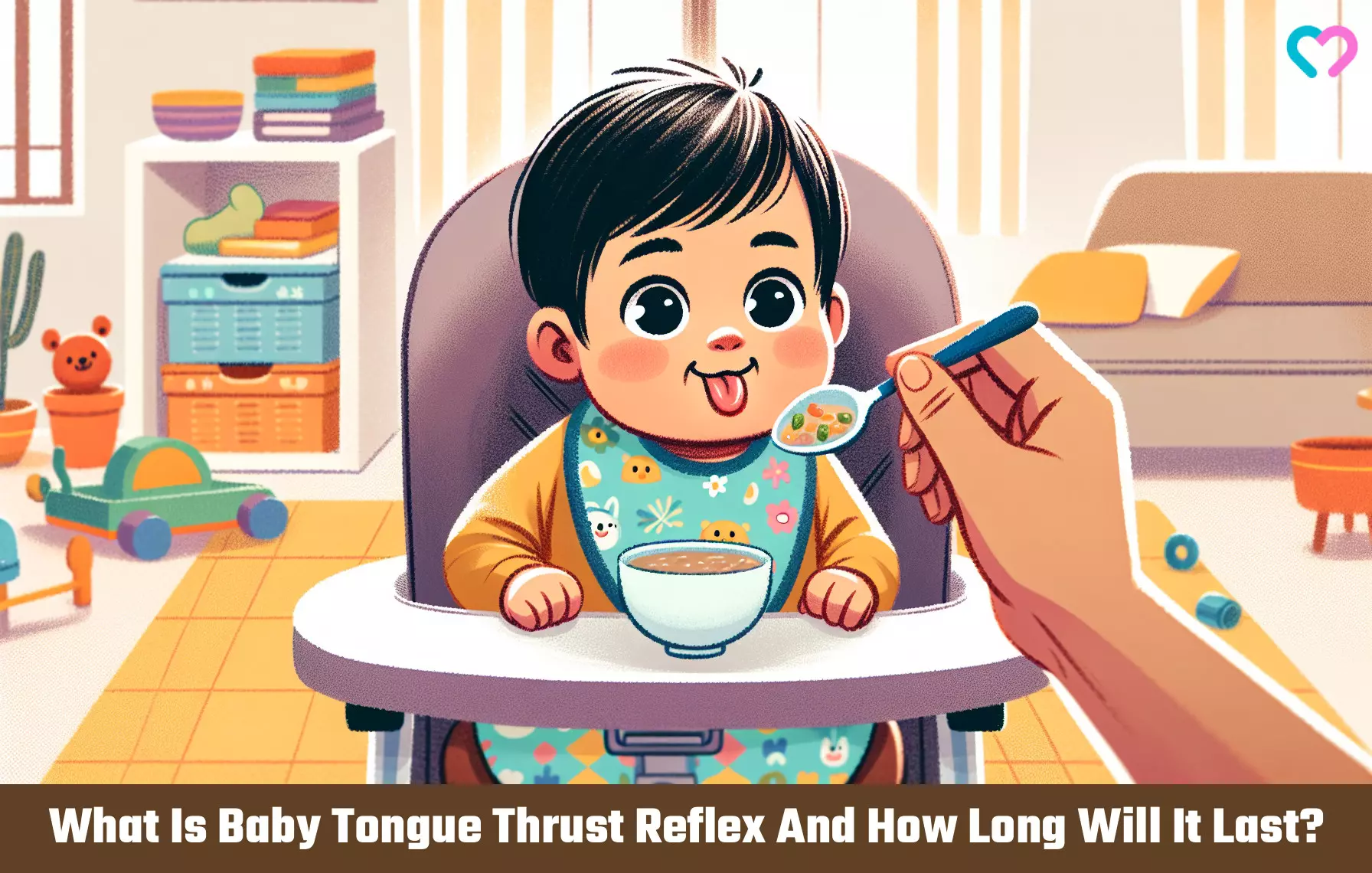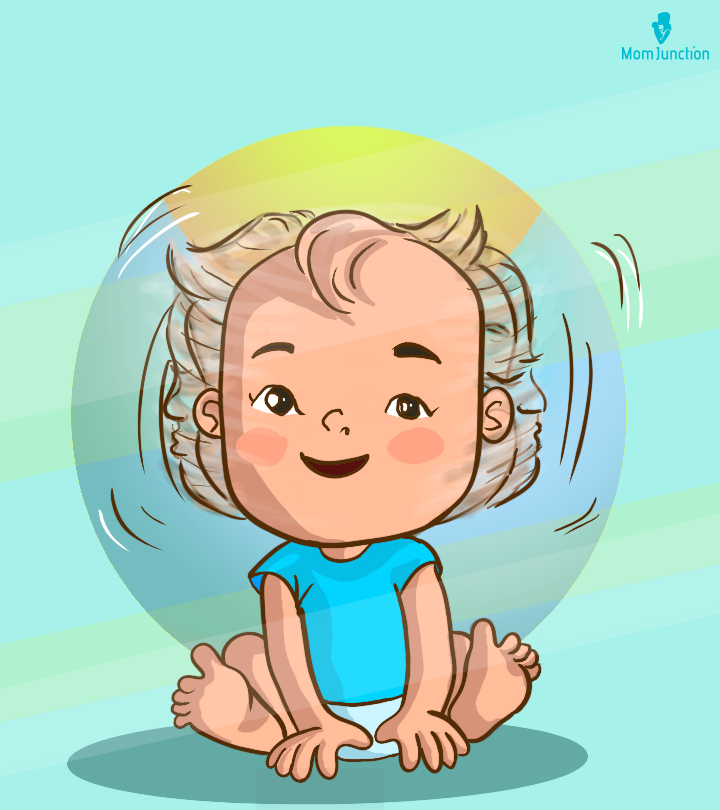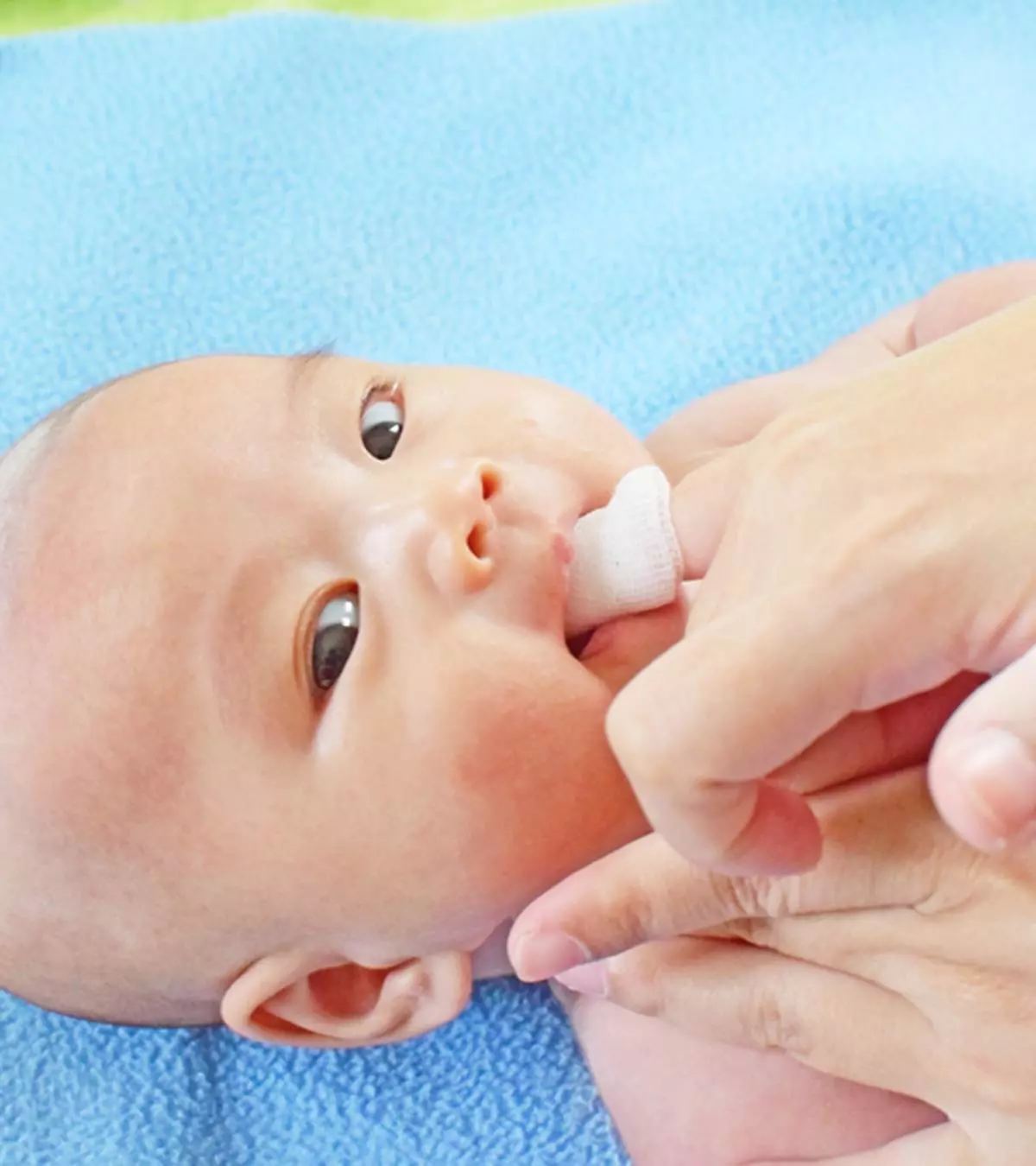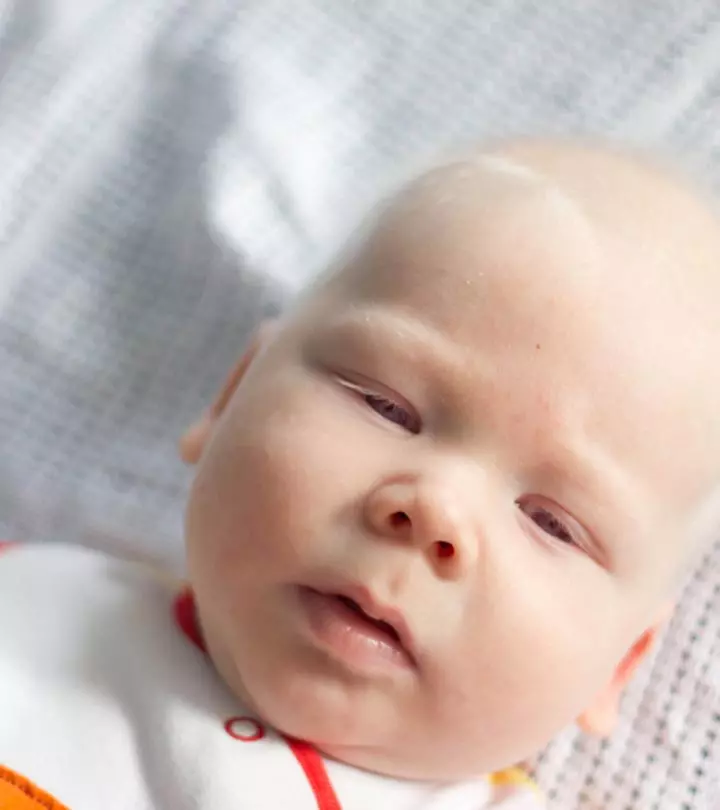
Image: ShutterStock
The tongue thrust reflex in kids, also known as the extrusion reflex, may interfere with speech development and cause orthodontic problems related to teeth alignment. This reflex occurs when an infant opens their mouth and extends their tongue when the lips touch (1). It is a newborn reflex that is a sign of normal development. The extrusion reflex prevents babies from choking on foreign objects and foods. It disappears as the baby grows, usually by around four to six months. However, you may seek medical care if the reflex stays much beyond infancy. Read on to know about the tongue thrust reflex in kids and signs of concerns.

Key Pointers
- Extrusion reflex in babies is part of their development that causes them to stick their tongue out when their lips are touched.
- It indicates a healthy functioning of the musculoskeletal and nervous systems.
- If the reflex persists even after six months of age and starts interfering with the weaning process, it could indicate an underlying problem that requires medical intervention.
Why Do Babies Have Extrusion Reflex?
The primitive reflexes in babies are spontaneous, involuntary actions that are a part of a baby’s normal development. Some of these reflexes occur during a specific developmental stage and then diminish as the baby grows. The presence of these reflexes helps determine if the baby’s nervous system and musculoskeletal systems are working fine (17).
The extrusion reflex is one of the newborn reflexes. It causes a baby to extend out their tongue as an involuntary response to their lips being touched. It does not interfere with the baby’s ability to latch onto a breast or bottle nipple but prevents them from feeding from a cup or a spoon. Along with the gag reflex, it lets the baby expel any solid food if they are not ready for it (2). Thus, this oral reflex protects the baby from choking or aspiration due to solid foods and other foreign objects.
When Does Extrusion Reflex Develop?

The extrusion reflex is present at birth, indicating that the baby develops it during fetal life. It is not precisely known when the fetus develops this reflex. It may develop between 32 and 36 weeks of gestation when other newborn reflexes, such as the sucking reflex, also develop (3).
When Does Extrusion Reflex Disappear?
The extrusion reflex disappears between the ages of four and six months (4). It is the age range when babies are ready for solids and can sit without support (5). Since the baby is ready to transition to solid food, the extrusion reflex is no longer needed.
There are other signs that accompany the fading extrusion reflex and indicate the baby’s readiness for solids. According to the Centers for Disease Control and Prevention (CDC) and the American Academy of Pediatrics (AAP), an infant is ready to transition to solids when they display the following attributes (6) (7).
- Ability to sit in a high chair or feeding table without support and with good head control
- Opens mouth when the food is offered, or a spoon approaches them
- Swallows food and does not push it out of the mouth
- Ability to transfer the food from the front to the back of the tongue
- Doubles their birth weight
If you are unsure if the baby still has their extrusion reflex, you may test to check its presence.
How To Test If Baby’s Extrusion Reflex Persists?
Parents can check for extrusion reflex by offering a clean spoon to the baby. If the baby thrusts their tongue and pushes the spoon, then they still have the extrusion reflex, which is an involuntary movement. If the baby accepts the spoon, you may assume that the extrusion reflex is gone.
Siti Syuhada, a blogger and a mother, shares why she introduced solid food to her baby (Ryan) at just five months. Among the various reasons that she observed in her baby, she says, “He has stopped the extrusion reflex, (sticking her tongue out), when you put a spoon in her mouth; PASS (i).”
Babies older than six months seldom have tongue thrust, and parents can begin offering them solids. However, some babies may continue to have extrusion reflex despite being ready for solids. You may have to see a healthcare provider in such cases.
When To See A Doctor?

Consult a pediatrician if your baby has extrusion reflux beyond the age of six months. A baby with persistent extrusion reflex may also display the following signs (8).
- Too fast, too slow, or messy eating with constant dribbling of food
- Unable to close the lips completely
- Baby sticking tongue out when the mouth is at rest or when the baby eats or talks
- Problem chewing solid food
- Speech problems in case of older babies
Persistent tongue thrusting in babies could indicate an orofacial myofunctional disorder (OMD), which may lead to orthodontic problems, such as misaligned permanent teeth, later in life (9). It may also affect the baby’s speech development by causing difficulties with articulation.
A pediatrician or an orthodontic specialist will suggest the appropriate treatment plan to treat the underlying problem, such as orofacial muscular problems, for abnormally persisting extrusion reflex. The treatment plan typically includes weekly sessions and follow-up appointments over a few months. Treatment focuses on proper tongue and mouth posture, correct swallowing, and tongue placement for speech. The therapist will also assign home exercises to support progress (8). You can help by making the child practice these sessions and ensuring they complete them consistently.
 Point to consider
Point to considerDos And Don’ts While Observing Your Baby’s Extrusion Reflex
The extrusion reflex is one of the primitive neonatal reflexes that helps you know that your baby is developing typically. This reflex plays an important role in the early development of your baby; therefore, here are some points you should know while you observe the extrusion reflex in your baby.
Dos
- Understand that this reflex is important to help your baby latch on to nipples and prevent choking on solids and foreign objects.
- Wait to introduce solid food to them until your baby has lost the tongue thrust reflex, i.e., around 4-6 months of age.
- Make sure to give them enough tummy time to strengthen the head and neck muscles (18).
- Keep a close eye on their developing milestones as they learn to swallow food and gain more weight.
Don’ts
- Don’t try to feed solid foods to the baby too early in life.
- Don’t assume it will disappear on its own. If your baby’s extrusion reflex persists beyond six months of age; take them to a pediatrician immediately.
- Prevent your baby from sucking thumb as it encourages tongue thrust (19).
Similarly, don’t use pacifiers and sippy cups too much beyond their recommended age (19).
What Other Reflexes Do Babies Have?
The following are other newborn reflexes that are present at birth or develop later after birth (1) (3).
- Sucking reflex: If a breast or bottle nipple is placed on the baby’s lips and touches the roof of the baby’s mouth, they automatically begin to suck. The reflex usually wanes by four months of age. It appears around 32 weeks of pregnancy and matures at about 36 weeks. Premature babies may have an underdeveloped sucking reflex.

- Rooting reflex: If the corners of the baby’s mouth, cheeks, or lips are touched, the baby turns in the direction of touch and opens their mouth. Rooting reflex is a reflexive action that helps babies locate the breast or bottle nipple and begin feeding. The reflex tends to fade away by four months of age.
- Galant reflex: When a baby is placed face down, and the skin along one side of the spine is stroked, the infant will respond with a quick sideways movement toward that side. This reflex emerges around 4 to 6 months of age (10).
- Snout reflex: If gentle pressure is applied to the baby’s closed mouth, the baby will respond with a puckering or pursing of the lips (11).
- Babinski reflex: The Babinski reflex is characterized by the extension of the big toe and the spreading of the other toes when the sole is stroked. This reflex is considered normal in children up to the age of two, typically disappearing as the child grows, sometimes as early as 12 months (12).
- Moro or startle reflex: Moro reflex occurs when the baby is startled by a loud noise or movement. The baby may throw their head back, extend their arms and legs, and pull them back. The reflex diminishes by two months of age
 Quick fact
Quick fact
- Tonic neck reflex: If the baby’s head is turned to one side, their arm on that side straightens, and their opposite arm bends. It is also called the fencing position, and the reflex wanes by five and seven months. The baby can roll over only after this reflex disappears.
- Grasp reflex: If you touch or stroke your newborn’s palm, they grasp your finger or the object by closing their fingers in a grasp. It is also called palmar grasp reflex and diminishes between five and six months of age. Voluntary grasp develops only after this reflex grasp disappears. A similar reflex in the feet disappears at 9 to 12 months of age.

- Stepping reflex:If the baby is held upright with their feet in contact with a surface, they begin to move their legs in a stepping action, as if climbing a flight of stairs. The step reflex in babies wanes by the time they are two months old.
 Did you know?
Did you know?Frequently Asked Questions
1. How common is tongue thrust reflex in babies?
All babies are born with tongue thrust reflex. It enables them to feed on a breast or bottle and prevents choking. Ideally, this reflex should disappear by six months when the baby starts consuming solid foods (1).
2. Can a pacifier cause tongue thrust?
Prolonged use of pacifiers may affect a baby’s swallow patterns, causing their tongue to stick out while swallowing. It may result in tongue thrusts in babies above six months (13).
3. Can exercises or therapies help my child overcome the tongue thrust reflex?
Exercises that could help a child overcome the tongue thrust reflex include lip and tongue exercises such as balloon or bubble blowing, whistling, spoon holding between lips, drinking from a straw, tongue clicking, tongue-nose touch, tongue-chin touch, and tongue push-ups. Vibrating toothbrushes, air sucking, teeth counting, and cheek exercises may also be helpful (14).
4. How do orthodontists fix tongue thrust?
Orthodontic management of tongue thrust involves using habit-breaking appliances such as tongue cribs and other myofunctional therapies for correcting tongue position (14).
The tongue-thrust reflex helps protect the baby from aspiration. This reflex disappears between the age of four to six months, i.e., when the baby starts to feed on solid food. This reflex after the age of six months may be concerning and may indicate an underlying orofacial myofunctional disorder. If not treated, this may further lead to orthodontic problems and misalignment of teeth. If you observe that your infant still has the reflexes post six months, consult your pediatrician for a clinical assessment.
Infographic: Ways To Help Babies If The Tongue Thrust Reflex Turns Into A Disorder
Although the extrusion reflex is a part of the baby’s developmental milestone, its persistence beyond the expected period may become a disorder. This can interfere with the child’s speech and eating habits. Hence if your baby hasn’t grown out of this reflex and is displaying signs of concern, the steps mentioned below may help to manage the condition.
Some thing wrong with infographic shortcode. please verify shortcode syntax
Illustration: What Is Baby Tongue Thrust Reflex And How Long Will It Last?

Image: Dall·E/MomJunction Design Team
Watch this video to understand the difference between tongue tie and tongue thrust, and find the answers you seek.
Personal Experience: Source
MomJunction articles include first-hand experiences to provide you with better insights through real-life narratives. Here are the sources of personal accounts referenced in this article.
i. Ryan 1st Solid Food @5MO…!!!https://sitisyuhada.blogspot.com/2011/11/ryan-1st-solid-food-5mo.html
References:
1. Development of Infant Feeding Skills; Wired International
2. Guide to Breastfeeding; NHS UK
3. Newborn Reflexes; Stanford Children’s Health
4. When Can My Baby Start Eating Solid Foods?; Rady Children’s Hospital-San Diego
5. FAQ: Introducing Your Baby to Solid Foods; UCSF Benioff Children’s Hospital
6. When, What, and How to Introduce Solid Foods; CDC
7. Starting Solid Foods; AAP
8. What is a Tongue Thrust?; Intermountain Healthcare
9. Orofacial Myofunctional Disorders (OMD); Cincinnati Children’s Hospital Medical Center
10. Neuro/Reflexes Stanford Medicine; Nova Southeastern University Center
11. The Suck, Snout, Palmomental, and Grasp Reflexes; NCBI
12. Babinski reflex; National Library of Medicine
13. The Effects of Extended Pacifier Use by Infants; Sensory Solutions
14. Moro Reflex; NCBI
15. Rooting Reflex; Cleveland Clinic
16. Sejal S Shah et al; (2025); Orofacial Myofunctional Therapy in Tongue Thrust Habit: A Narrative Review; NCBI
17. Infant reflexes; Icahn School of Medicine at Mount Sinai
18. How to Know When Your Baby Is Ready for Solids; Penn Medicine Lancaster General Health
19. Tongue Thrust; Cleveland Clinic
Community Experiences
Join the conversation and become a part of our nurturing community! Share your stories, experiences, and insights to connect with fellow parents.
Read full bio of Dr. Pooja Parikh
Read full bio of Swati Patwal
Read full bio of Rohit Garoo
Read full bio of Anindita Ghatak

















